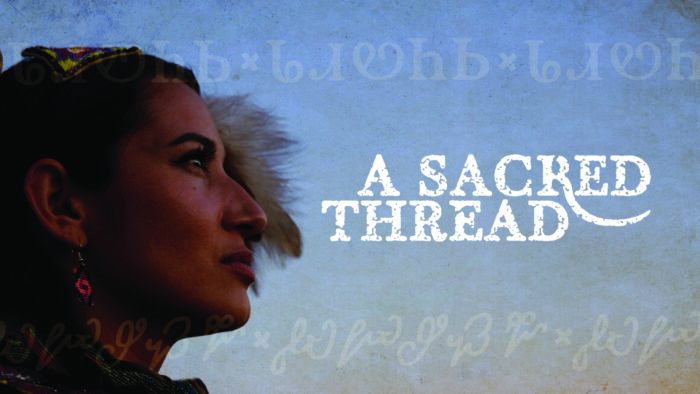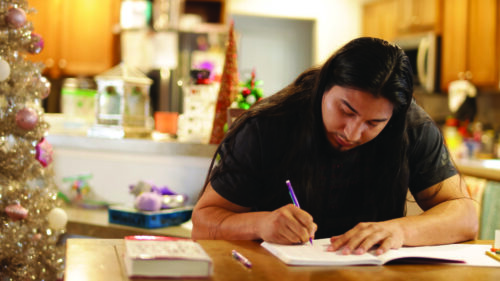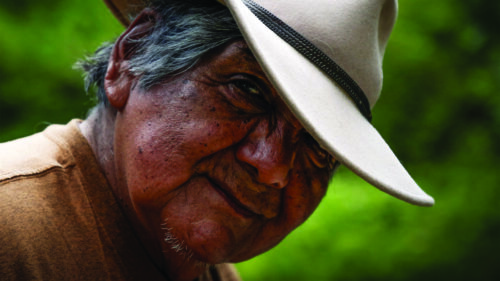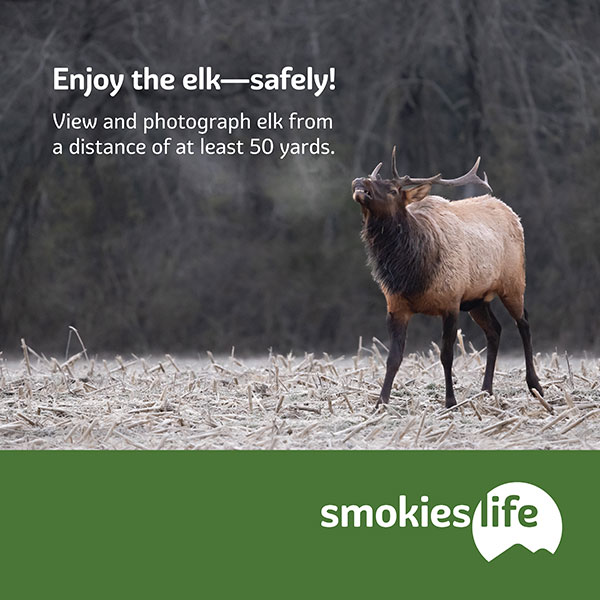
Angelina Jumper, the cultural resources supervisor of the Junaluska Museum and a member of the Eastern Band of Cherokee Indians (EBCI) from Tutiyi, is one of the main voices of the film. (Images courtesy of PBS North Carolina)
By BROOKLYN BROWN
One Feather Reporter
SNOWBIRD, N.C. – A Public Broadcasting Service (PBS) North Carolina documentary about Cherokee language and cultural revitalization in Tutiyi (Snowbird) titled “A Sacred Thread,” premiered on July 31. Filmmaker Brooks Bennett, who has worked closely with Tutiyi community members in the past on other projects, condensed two years of filming into the hour-long documentary.
Executive Producer Heather Burgiss felt that the documentary was critically important to make, “This is a project that we feel very passionately about. It’s right up our mission alley, and I’ve been working with Brooks for three years on this project, Brooks had been working on the Matriarch Mural project and really got to know the people and the place and the stories of the Snowbird Cherokee, and he really developed relationships that led to seeing that there was an underrepresented story here, and that was the mission that really aligned with what we do.
“Snowbird Cherokee is a nuance; in the dialect and trying to keep the language alive for future generations, and not just the language, but the culture and looking back at the land and looking at place names and the heritage. So, we just felt we had a responsibility if we could, to try to help amplify the voices,” she said.
Angelina Jumper, the cultural resources supervisor of the Junaluska Museum and a member of the Eastern Band of Cherokee Indians (EBCI) from Tutiyi, is one of the main voices of the film.

Cassidy Galaviz
“It was a really cool experience and I’m a talker, so reflecting on things and talking about them, it just helped me understand more and I think learn more, not just about myself, but how important the work that we were doing was, and that really came out through the film. I was really excited that that was what was captured and what [Brooks] was able to convey for us,” Jumper said.
“I feel like it really captured the interconnectivity of what we all do, and it showcased things that I don’t think that you can get from just talking to people about the language and the culture. And then you’ve also got this element of the natural environment that I feel like when we talk about language and culture that gets left out or we just don’t think about it.”
A major part of the film was Jumper’s discovery regarding her family’s land, the Wachacha tract of land that was unethically taken by the U.S. Forest Service in the early 20th century and now operates as Rattler Ford Campground.
“That’s probably one of my favorite things that developed out of the film is that when I had started work, I had found remnants of Register of Deeds stuff, and I was like, ‘What is this? This is my family. This is Wachacha family stuff.’ And then I started digging deeper,” she said.
“I think T.J. [Holland] had begun that research, and Louise [Reed], when I was working with her before she passed, I had the privilege of being able to talk about it with her, because it was her family, too, and she had known about it… Louise is the woman that taught me seven generations behind me, all the names of the people who existed behind me, and if I hadn’t spent that time with her then I wouldn’t have that knowledge. We filmed maybe two weeks after I had pulled out all that stuff from the U.S. Forest Service archive, so that was really raw. I’m glad it happened that way, because watching it back I’m like, ‘Wow, that did say what needed to be said.’”
Gilliam Jackson, a Cherokee fluent speaker from Tutiyi, also starred in the film and discussed sacred sites including his family’s graves that are also now managed by the U.S. Forest Service. “I think the message that I wanted people to understand was the amount of control and the lack of control that we have as Indigenous people on stolen lands. We gather together sometimes with our family, and most of us in our community come from the Wachacha family. My grandmother was a Wachacha, and as I understand it, I think there were 13 or 14 siblings, and most of them are buried in that burial ground. In order for us to just go out and clean and cut weeds and rake, we have to get permission from the Forest Service,” he said.
“I’m truly grateful to the people who were involved in the documentary. I just think that people need to know Snowbird is a very culturally rich community, and by far, we have the greatest percentage of Cherokee speakers per capita. The Trail of Tears started right above where the Ingles Supermarket is now in Robbinsville. We had at one time three mounds, and things that have been written about Cherokees in North Carolina often excludes Snowbird.”

The late J.C. “Eduts” Wachacha
Jackson works with second language learners in the Dadiwonisi adult language program, and he highlighted one of the program graduates as making a powerful statement about the importance of Cherokee language and culture. “During her graduation speech, she said ‘I have become a Cherokee woman.’ She was a Cherokee woman by enrollment and by biological blood, but it was a lot more meaningful when she said, ‘I became a Cherokee woman,’ meaning I’m learning the culture. I’m learning the language. My blood is different now.”
Cassidy Galaviz is the Dadiwonisi program supervisor and a member of the EBCI from Tutiyi. The film also followed Galaviz’s journey towards fluency, with the late Cherokee fluent speaker J.C. Wachacha, or “Eduts,” being a mentor and supporter for Galaviz. “I really enjoyed this experience. I think just some of my favorite moments was honestly just being in Eduts’ garden. I really enjoy my job, I really enjoy all of it, helping bring a community together and working with the students, working with the language,” he said.
With Eduts’ unexpected passing during filming, Galaviz spoke to the significance of having this footage of Eduts speaking. “It means a lot. I’ve always been very aware of capturing those things, even as a kid, knowing, understanding how quickly speakers are passing, how fast the language is ‘dying out,’ all those things. It is greater to me because it’s captured in video. To be able to actually see the reactions, because there’s a lot of nonverbal communication with the speakers. Whenever they talk, they’ll give out hand gestures and things like that, which videos really do capture. We can still see him. We can still hear him. We can still talk to him.”
Galaviz is hopeful that the film will encourage more language learning. “Hopefully it does light a fire in people a little bit to want to learn the language more. And honestly, even if not, it’s perfectly fine. We’re still going to learn, we’re still going to keep going. We’ll pass it on for anybody who wants to. But for those that do, hopefully they now have resources and things like that to know where to go, to know who to look for. If they see me, they can try to talk to me. Even if they just say ‘siyo,’ I’m going to say ‘siyo’ back. If that’s all you know, use it. I’ll be happy either way.”
Filmmaker Brooks Bennett has built strong bonds with the Tutiyi community, who are the subject of the film. In 2017, Bennett was just passing through on a trip with his wife when they stopped at Cherokee woodcarver Billy Welch’s shop. “That was my first introduction to Snowbird people, and I bought a little bear from him. He told me kind of the broad stroke story, and I always kept that bear on my desk and I would look at it whenever I was doing a project and think if there’s ever an opportunity to collab with PBS on something like that, then that’s what I think I was pulled here for.”
Bennett noticed a ‘thread’ tying together Cherokee land, culture and people, and that thread is the language.
“There’s a metaphysical quality or this spirit behind everything story wise, content wise, whatever I’m experiencing in nature or with Buffalotown or with Billy [Welch] or even the Matriarch Mural project, and that’s kind of the title is it’s the spirit that runs through everything in the community and it’s the spirit that motivates people to research their history and the spark that initiates those crafts. The more Cherokee I learn, the more I understand that these things are better expressed in the language, and we don’t have the right vocabulary in English to really convey that meaning or the essence that was developed here.”
Bennett said filming in Eduts and his brother Mike Wachacha’s garden was one of the more spectacular parts of the project. “The history and that connection and to be able to go there and it’s not just on paper. I think that’s the biggest thing is real world experiences in the places where the language has been spoken forever.”
With encouragement from Eduts’ wife, Jeanne, Bennett captured parts of Eduts’ funeral for the film. “I got the invite to the funeral from Jeanne, and I went to the service at the church in Snowbird without a camera, and I just wanted to be there for this community that I love. So, Jeanne was actually the one who encouraged me. She’s like, ‘He always wanted to be in front of the camera. He always wanted to tell the story. This is no different and you shouldn’t think of it as anything different.’ I was very reluctant in that moment because this is my family now, and I didn’t know if it was right to bring a camera, but when Jeanne wanted it, I felt like it was kind of my duty to make sure that that was preserved with everything else, and I’m so glad that I did. I stayed very in the background the whole time. You can see how my style of filming was different in every other moment than that.
“It was hard, but it was beautiful. And seeing CLMAP [Cherokee Language Master Apprentice Program] and Dadiwonisi come out and sing, I think it was exactly what he would want. And I think the final line from the film, ‘I think that they can still see us and that they’re watching over us,’ I felt like he was there that whole time.”





